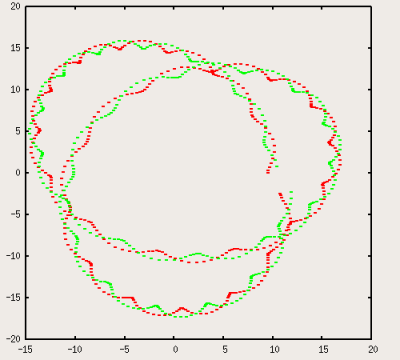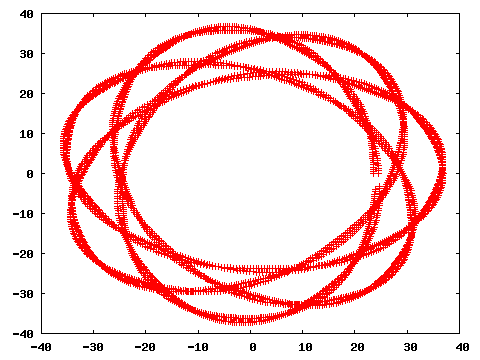The New York Times published a short but good article about Emmy Noether yesterday.![]()
Category Archives: Physics
Einstein’s Happiest Thought…Doomed?
 When Albert Einstein first realized that gravitational mass and inertial mass were the same thing, the resulting thoughts led him to expand the theory of special relativity into general relativity. He called this equivalence of gravitational mass and inertial mass the “Equivalence Principle”, and called it his “happiest thought”. Recent calculations posted in a paper on the arXiv, assert that this is not true at the quantum scale. The most important aspect of this research is that it should be experimentally verifiable. At least that is what the author of the Physics ArXiv Blog thinks.
When Albert Einstein first realized that gravitational mass and inertial mass were the same thing, the resulting thoughts led him to expand the theory of special relativity into general relativity. He called this equivalence of gravitational mass and inertial mass the “Equivalence Principle”, and called it his “happiest thought”. Recent calculations posted in a paper on the arXiv, assert that this is not true at the quantum scale. The most important aspect of this research is that it should be experimentally verifiable. At least that is what the author of the Physics ArXiv Blog thinks.
Books: “Particle Physics A Very Short Introduction” by Frank Close

I found this book in the library the other day and found it to be a very good introduction to the basics of particle physics. I liked the fact that it explains the basics of the experimental side of particle physics as well as introducing the three families of leptons and quarks. Too often, popular science books explain the various subatomic particles with out giving you any idea of how we actually know of their existence. Because of this, I think disbelief tends to creep in. But Close does an excellent job of explaining the basics of how accelerators operate and also the basics of how detectors work. And he does all this in only 129 pages! Very short indeed, and highly recommended.
Iterated Function Systems and Fractals
This code generates fractals based upon an iterated function system (IFS). Several input files and a Makefile are included. The code is written in C++, and distributed as a tarball. I did this for a class at the University of Utah, but it is based upon a homework assignment for a computer graphics class at MIT (6.837).
Below is the famous Barnsley fern which was generated by an IFS with just four transforms!

Dark Matter and Particle Physics
Michael Peskin recently posted an article to the arxiv entitled “Dark Matter and Particle Physics”. The article is an almost layman’s guide to how the WIMP model of dark matter might soon be partially validated experimentally at the LHC.
In the article he outlines the reasons why most matter in the universe is dark or in other words does not emit light or radiation, and thus is normally only detected via its gravitational effects. He then goes on to describe the WIMP model for dark matter and its predictions. Next he talks about how the LHC might detect WIMPs:
The discovery of events at the LHC with apparent unbalanced momentum will signal that this accelerator is producing weakly interacting massive particles. However, it would be far from clear that this particle is the same one that is the dominant form of matter in the universe. To demonstrate this, we would need to correlate properties of the WIMP that we observe at the LHC with astrophysical observations.
There are two possible ways to observe WIMPs outside of the LHC. First is the direct approach of observing the scattering of a WIMP from a nucleus in an extremely sensitive detector located deep underground in a mine to minimize noise. The second method is to observe gamma rays emitted from pairs of WIMPS annihilating each other. These gamma rays should have a characteristic spectrum and be most commonly found coming from parts of our galaxy where the concentration of dark matter is highest, namely near the center of the Milky Way.
If the mass of the WIMP seen at the LHC is the same as the mass from astrophysical detection experiments, this will provide strong evidence that the LHC is producing the true particle of dark matter.
Thanks to Hwasung “Mars” Lee for pointing out this article in his blog.
New RSS Feed for Flash Cards Page
I added an RSS feed to update anyone interested on changes I’ve made to my Math and Physics flash cards page.
Orest Symko’s Research on BoingBoing.net
I have an RSS feed from Boing Boing on my Google home page, and today they have a posting about University of Utah physics professor Orest Symko! The post describes his research into turning waste heat into electricity via an intermediary acoustic step.
It seems to me that the solar updraft tower might be a good match for this technology.
Kaliope Now Includes Gravitational Potentials
I’ve added a C++ class that handles gravitational potentials to my Kaliope project. Below is a picture of a binary cluster orbiting around a logarithmic potential well. A logarithmic potential is the simplest kind of potential well. It corresponds to an inverse distance radial force field.
Here is a slightly different simulation, with each body given its own color, so it is easier to see individual paths:

XKCD
I’ve been a big fan of Dilbert for years now, but I recently found a great webcomic that I’ve started reading daily called XKCD. The tagline is: A webcomic of romance, sarcasm, math, and language. The drawings are simple stick figures, but it is the situations and ideas that are interesting and funny.
ADS Digital Library
While googling for information on the Virial Theorem, I ran across a really cool page hosted at the Harvard ADS system. ADS stands for Astrophysics Data System, and it is primarily an abstract search engine that helps you locate journal articles mostly in the realm of Astronomy and Astrophysics, but they also have a small virtual library of books that you can freely download.
Here are the titles I found interesting:
- The Foundations of Celestial Mechanics by George W. Collins, II
(1989, 2004). - The Fundamentals of Stellar Astrophysics, by George W. Collins, II
(1989, 2003). - Fundamental Numerical Methods and Data Analysis by George W. Collins, II
(1990, 2003). - The Virial Theorem in Stellar Astrophysics, by George W. Collins, II
(1978, Pachart Publishing House, Tuscon, Arizona).
If you want to concatenate all the separate PDF chapters, I recommend using the texexec method oulined in this web page by Matthew Skala.
Command Line Unit Conversion Utility
I found a handy tool for figuring out unit conversions quickly, and yes I am aware that Google does this, but sometimes the command line is more convenient. Here are some examples of how to use it:
$ units lightyear parsec
* 0.30660139
/ 3.2615638
$ units inches feet
* 0.08333333
/ 12
$ units 2m cm
* 200
/ 0.005
So the first line tells you what value to multiply the second unit by to make the conversion. And the second line is the inverse operation, that is, what you divide the second unit by to obtain the same value in the first unit.
To install this on a Debian/Ubuntu system, just run the following command:
$ sudo apt-get install units
Video: Feynman QED Lectures
I found a link via Marcus Woo’s blog to a superb set of videotaped lectures by Richard Feynman on Quantum Electrodynamics or QED. He masterfully describes the basics of quantum mechanics at the layman’s level. I’ve only watched the first video completely through, but I was very impressed with the clarity with which he explained the subject. The video requires the Real Player.
Book Review: The Trouble with Physics
 This book is Lee Smolin’s attempt to diagnose the physics community. Smolin entered graduate school in 1976, at the end of arguably the most fruitful era ever known to physics. However, since the 1980s no new fundamental challenges to the canon of physical theory have succeeded in reshaping how we view our universe. Although this fact troubles and frustrates Smolin, it is not this lack of substantial progress that he cites as the problem with physics. The problem as he sees it is that the majority of theoretical physicists are barking up the wrong tree, namely string theory. He argues very convincingly that string theory fails as a unifying theory. In the introduction he cites Nobel laureate Gerard ‘t Hooft as saying,
This book is Lee Smolin’s attempt to diagnose the physics community. Smolin entered graduate school in 1976, at the end of arguably the most fruitful era ever known to physics. However, since the 1980s no new fundamental challenges to the canon of physical theory have succeeded in reshaping how we view our universe. Although this fact troubles and frustrates Smolin, it is not this lack of substantial progress that he cites as the problem with physics. The problem as he sees it is that the majority of theoretical physicists are barking up the wrong tree, namely string theory. He argues very convincingly that string theory fails as a unifying theory. In the introduction he cites Nobel laureate Gerard ‘t Hooft as saying,
“I would not even be prepared to call string theory a ‘theory,’ rather a ‘model,’ or not even that: just a hunch. After all, a theory should come with instructions on how to deal with it to identify the things one wishes to describe, in our case the elementary particles, and one should, at least in principle, be able to formulate the rules for calculating the properties of these particles, and how to make new predictions from them. Imagine that I give you a chair, while explaining that the legs are still missing, and that the seat, back and armrest will perhaps be delivered soon. Whatever I did give you, can I still call it a chair?”
Smolin sees the widespread adoption of string theory as a continuation of the “shut up and calculate” mentality of the particle physics era that was so successful. He also argues that this follow the leader attitude is hurting diversity, especially the young physicists with bold new ideas. Not becoming part of an established research group and striking out on one’s own research path is tantamount to career suicide in theoretical physics, at least for those without established reputations. The notable exception of course is Einstein, but people like him are rare.
He divides his argument into four parts. In the first section, he sets the stage by giving a brief overview of the five great problems in theoretical physics, and the early attempts at unification. I especially liked how he described his set of heuristics for judging the promise of a new theory.
In the second section he gives a whirlwind history of string theory up to current times. This part of the book will be difficult for someone not familiar with the jargon of string theory. I recommend reading Brian Green’s “The Elegant Universe” before tackling this book, as it is a good introduction to string theory.
The third section examines some alternatives such as Smolin’s own research in loop quantum gravity as well as other programs such as Alain Conne’s non-commutative geometry research.
The final section looks at the physics community from a sociological perspective, attempting to understand how its internal power structure strongly encourages certain behaviors and punishes others. As a soon-to-be graduate student, I found this section to be very informative.
I strongly recommend this book. I however admit, that with only a bachelor of science degree in physics, I’m not yet qualified to judge string theory let alone even the Standard Model, but I can say that the book is well-written and I found it very interesting.
Physics Nobel Prize Winners on Science Friday
Physicists George Smoot and John Mather won the 2006 Nobel Prize in physics for their work in analyzing the cosmic microwave background radiation, work that helped to support theories about the Big Bang. You can learn about their work on NPR’s Science Friday podcast.
Caltech Physicists Successfully Split the Bill
PASADENA, CA—Sequestered in a private booth at a Pasadena-area Cheesecake Factory for nearly 25 minutes, a party of eight California Institute of Technology physicists emerged exhausted but visibly excited Friday evening after successfully splitting the bill…
What Is a Wave Function?
My younger brother Jeff asked me what a wave function is the other day. The following is my response.
What is a wave function? The short answer is that it is a probability amplitude, that also happens to solve Schrodinger’s equation, but I’m sure that won’t help you much.
When physicists started looking at really small things like atoms, they discovered that the rules of classical mechanics no longer apply. That is that dynamical variables like position, velocity, momentum, acceleration, etc. can no longer be computed via Newton’s laws. They found that these dynamical variables come in pairs. For example position and momentum form a pair, so do time and energy.
The really big idea in Quantum Mechanics is Heisenberg’s uncertainty principle which states that the more carefully you measure one variable the more uncertain you will be about its corresponding partner variable. Imagine you were to use very precise lasers to measure the position of an atom, well the more precisely you know the position, the less knowledge you will have of its momentum. This is exactly analogous to ordinary waves. If you create a standing wave on a rope for example, you know exactly its frequency and wavelength, but it doesn’t make sense to even ask where the wave is because it is everywhere. Now imagine sending a single wave pulse along a taut rope, in this case you will have a fairly good idea of its position, but measuring its frequency is now problematic. Waves inherently predict the uncertainty principle.
After Einstein proposed that light behaves like particles with definite or quantized energy (in his famous photoelectric effect paper of 1905), Louis de Broglie posited that perhaps matter can behave like a wave as well. This was the pivotal intuitive leap that paved the way for Schrodinger. He decided that if de Broglie was right then there must be some wave equation that governs matter waves just like there is a wave equation that governs light waves discovered by Maxwell). So he set about trying to figure it out by applying de Broglie’s famous relations (E=hbar*omega and p=hbar*k which relate dynamical quantities usually associated with matter to dynamical quantities related to waves) to Maxwell’s wave equation. He found that if he slightly modified it and allowed the matter waves to be complex-valued, then the equation could be solved. Complex-valued simply means that the function returns two values, or in other words a complex number of the form a+bi where i is the square root of -1.
After physicists had a new equation to play with, they found all sorts of solutions, but for a long time, no one knew how to interpret what the solutions of the equation actually meant physically. Max Born proposed that solutions of Schrodinger’s equation are probability amplitudes.
If you square a probability amplitude you get a probability density which can be used to predict the likelihood of getting a certain value when you measure that dynamical quantity. That’s very abstract so let me make it more concrete. Once you have psi (a function which solves Schrodinger’s equation), you can predict the likelihood that your quantum system will have energy E, or the likelihood that the particle will be found at position x.
Dark Matter on Science Friday
Every Friday there is a show on NPR (radio) about various science topics. Last week Ira Flatow, the host of the show, talked to Sean Carroll, a cosmologist at CalTech about the recent discovery I mentioned in my last post. You can download and listen to the discussion from the Science Friday website.
MOND Theories Come Up Short
My brother Ryan pointed out yesterday’s NASA press release about recent observations made by the Chandra X-ray observatory which rule out MONDian theories as possible explanations for the galactic rotation curve problem. Beginning in 1933, astronomers have observed that galaxy clusters rotate around each other too quickly to be explained by Newtonian physics or even Einstein’s general relativity. Some scientists posited a halo of dark matter surrounding galaxies which could explain the rotation speeds. Other scientists attempted to modify newtonian dynamics hence the acronym MOND.
This discovery rules out MONDian theories as a possible explanation. Of course we still don’t have direct evidence for dark matter, but at least we can eliminate one path of exploration.
Nature has a more illuminating article on the subject, and they also link to the Astrophysical Journal preprint at arxiv.org.
